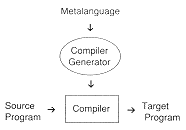
1.0 Introduction
Although the picture above implies that an entire compiler can be created by a compiler, in fact, compiler generators cannot yet generate entire compilers automatically.
Like compilers themselves, compiler generators are frequently separated into phases. For the front end of a compiler, the phases are often termed lexical analyzer generator, syntax analyzer generator (or parser generator) and semantic analyzer generator.
As the names imply, a lexical analyzer (or scanner) generator generates a lexical analyzer (or scanner), and a syntax analyzer (or parser) generator generates a syntax analyzer (or parser).
Generator phases for the back end of compilers are still very much a research topic although work has been done on code generator generators. Figure 1 shows how a compiler generator can be parametrized. The rectangular boxes show the standard compiler phases while the ovals show the corresponding generators. Figure 1 shows how a compiler generator can be parametrized. The rectangular boxes show the standard compiler phases while the ovals show the corresponding generators. The inputs to the ovals are termed metalanguages, which are languages that describe other languages. The front-end parts are shown grouped because often there is a single input file containing all the information needed to generate the front end of a compiler. In Figure 1, IR stands for Intermediate Representation.
Scanner generators are introduced in Section 1.3 and parser generators in Sec1.4. Attribute grammars and evaluator generators are introduced in Sec.1.5. For the back end, optimization and code generation will be discussed more from the point of view of automating or retargetting, and they are introduced in Section 1.6 and Section 1.7. This chapter is an overview of compiler tools. Algorithms and data structures are discussed within each chapter.

